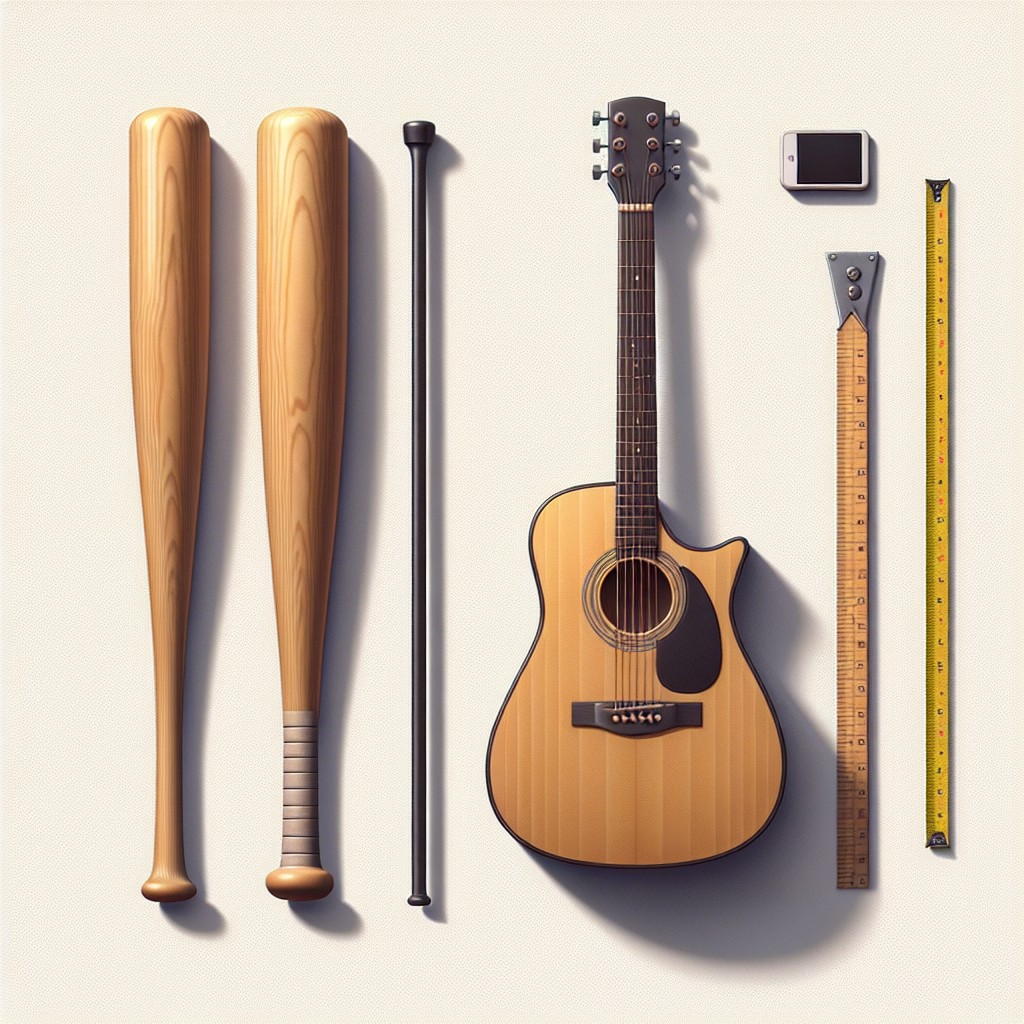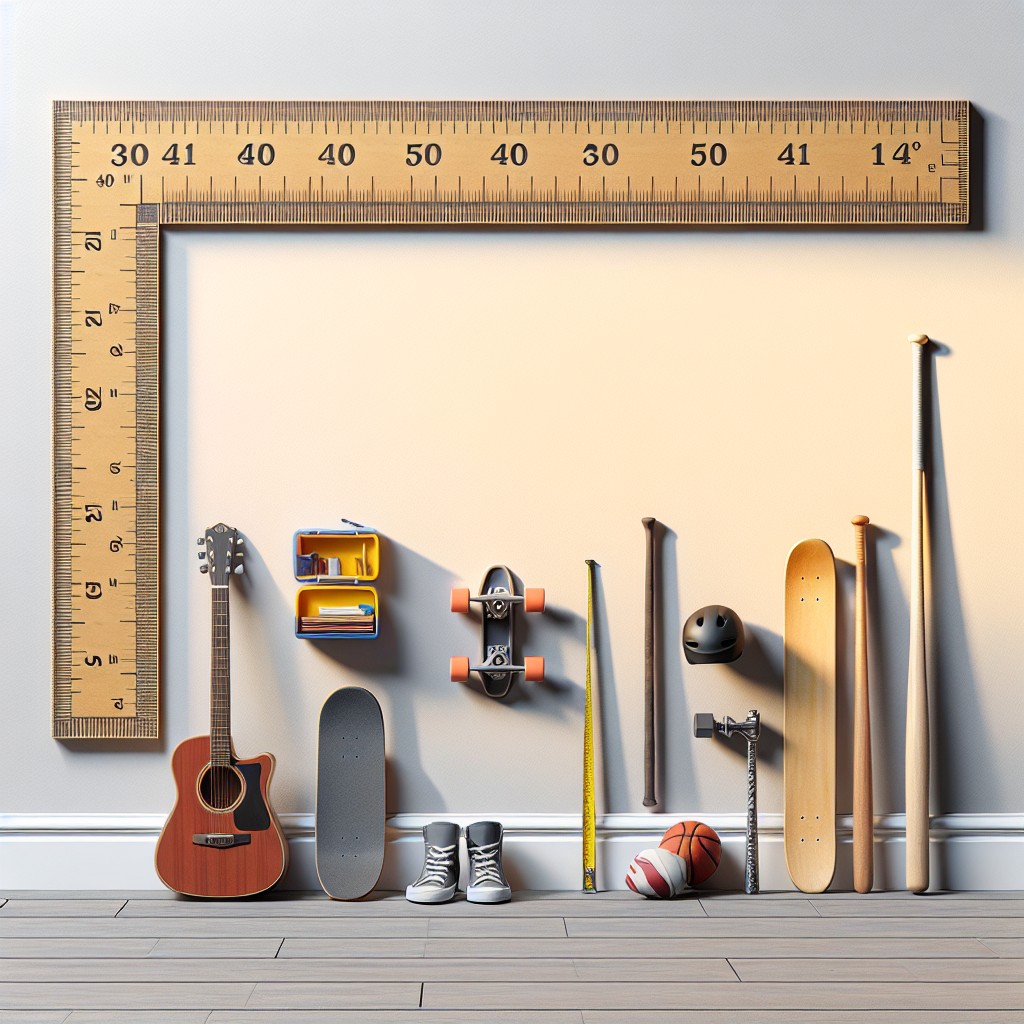Last updated on
Unravel the substantial dimension that the 40-inch measurement represents in this informative piece loaded with real-life examples, and get a grip on how to easily convert this size in light of diverse standards.
Key takeaways:
- 40 inches is slightly longer than a standard yardstick.
- Two Subway footlong sandwiches side by side equal 40 inches.
- A mid-size flat screen TV diagonally measures around 40 inches.
- A baby’s growth from head to toe by the end of the first year is close to 40 inches.
- In men’s apparel, a 40-inch waist is typically considered a larger size.
What's Inside
Understanding 40 Inches in Everyday Objects

Envision a standard yardstick, which measures 36 inches; now add an extra four inches. That span slightly exceeds the length of the yardstick, offering a tangible sense for the size being discussed.
Picture two side-by-side subway footlong sandwiches; their combined length touches 40 inches, a relatable visual for sandwich enthusiasts.
Consider the width of a mid-size flat screen TV, around 40 inches diagonally across, a common living room feature, illustrating the measurement with a tech twist.
A baby’s growth from head to toe, by the end of the first year, is close to this size, resonating with parents familiar with infant growth charts.
Each example bridges the gap between abstract numbers and the physical world, making the concept of 40 inches more accessible and grounded in common experiences.
Visual Comparison With Common Household Items

Imagine a standard yardstick – it’s 36 inches. Now add roughly the length of a new pencil, and you’ve hit the 40-inch mark.
This measurement could also be represented by placing two standard Subway footlong sandwiches end to end, with an additional 4-inch cookie for dessert, quite a filling visual!
Look at a twin-size bed – it’s usually around 39 inches wide, so think of a 40-inch line as the width of the bed plus an inch to spare.
If pizza is more your thing, envision a 16-inch extra-large pizza, and stack two and a half of those boxes lengthwise.
For a touch of whimsy, consider a lineup of about six and a half average paperback books, standing spine to spine, a mini library that stretches out to meet the 40-inch target.
These household comparisons offer a concrete sense of how lengthy 40 inches is in a familiar context.
Comparison to Human Body Parts
When you unfold a standard yardstick, it falls short by just 4 inches to measure up to 40 inches. This measurement is close to the length of an average three-year-old child from head to toe.
If you’re wondering how tall 40 inches would be on an adult, imagine it reaching up to about the hip level of a person who is 6 feet tall.
For a more tangible sense of the figure, consider the width of a large men’s shirt—it often spans approximately 40 inches around the chest. Imagine stretching an average scarf from end to end; you’re likely looking at a length that neatly aligns with this measurement.
In terms of limb comparison, think of an adult’s arm: from the fingertips to the opposite shoulder typically measures around 40 inches. If you’re a visual thinker, picture six standard 12-inch rulers laid end to end with an additional 4-inch segment—that’s the span we’re discussing.
In a practical application, if you’re reaching for something approximately 40 inches away, you’d likely need to take a step or two to get there unless you have an unusually extensive reach. This dimension speaks to the space within our immediate reach; providing context to this measurement makes it more than just a number—it’s a relatable, observable part of our world.
Inches in Sports Equipment
When you visualize the expanse of a standard tennis racket, it typically measures about 27 inches. So picture one and a half tennis rackets laid end to end, and you’ve got your 40 inches right there. It’s a similar length to a junior-sized hockey stick, which gives kids a comfortable grip and control during gameplay.
On the basketball court, the regulation rim stands 18 inches in diameter. If two of these hoops were fashioned into a figure-eight, the total length would approximate 40 inches. It’s a practical way to gauge the distance when considering the wingspan of smaller equipment, like youth basketball systems.
In the realm of golf, envision the driver, one of the longest clubs in a player’s bag, often coming in close to 40-45 inches. Holding a driver vertically gives you a concrete sense of that 40-inch reach, directly linking the theory of measurement to a tangible example.
These comparisons aren’t just whimsical thoughts; they offer a mental yardstick for understanding measurements in a world where inches often translate to performance and the precision of play.
Inches in Electronic Devices
When you sit back on your couch to enjoy your favorite movie, that flat-screen TV across the room might be a prime example of 40 inches measured diagonally. In the realm of televisions and monitors, screen size is king, and 40 inches has become a sweet spot for many living rooms, providing ample screen real estate without overwhelming the space.
Peering into your work life, office whiteboards can also span this length on their longer side, making room for brainstorming sessions or agile sprint plans. Meanwhile, in terms of sound, soundbars often stretch to this length, designed to sit elegantly beneath your TV, delivering audio that fills the room without taking over your living space.
Tablets and computer monitors are typically smaller, so a 40-inch measurement might instead relate to the width of your entire desk setup, accommodating a couple of monitors for a dual-screen experience beloved by multitaskers and gamers alike.
It’s useful to compare 40 inches to a standard yardstick, which is just 4 inches shorter. This perspective highlights the significance of this dimension when selecting electronics, articulating a boundary between cozy personal devices and expansive, room-defining gadgets.
Comparison With Architectural Elements
Venturing into the realm of architecture, 40 inches serves as a common benchmark for certain design elements. For instance, a standard countertop height is nearly 36 inches, so 40 inches is just a tad taller, reflecting a comfortable standing work surface for many individuals.
When discussing entryway widths, 40 inches far exceeds the typical interior door width of 30 inches, promising a spacious feel.
On a grander scale, consider the balustrade on a balcony or a staircase, where the height often resides in the 34 to 38-inch range for safety and code compliance; this places 40 inches slightly above what you might lean against comfortably.
Moreover, kitchen wall cabinets mounted to a standard height leave roughly 18 inches of clearance above countertops, suggesting two such spaces stacked would approach 40 inches—highlighting ample storage potential.
In the context of public spaces, it’s also worth noting that the height of an ADA-compliant public sink is precisely tailored to be no higher than 34 inches, emphasizing the consideration given to accessibility in design, with 40 inches then being a measure that exceeds these accessibility standards.
These examples illustrate how 40 inches plays a recurring role that interweaves functionality with design aesthetics in the construct of our daily environments.
Understanding 40 Inches in Apparel Sizing
Deciphering the dimensions on clothing labels can be mystifying. Take men’s pants, for instance. A 40-inch waist is typically what you’ll find as a larger size in men’s departments. It’s crucial to note that this measurement is the circumference, not the diameter.
For women, understanding dress sizes gets trickier since they don’t directly correlate to inches. Instead, to determine if a dress or a blouse is roughly 40 inches around the bust area, you’d look at sizes ranging from a 14 to a 16 in US sizing.
In maternity wear, 40 inches can refer to the bust, waist, or hip measurement, depending on the garment’s design. Expectant mothers may find the 40-inch mark as their pregnancy progresses, seeing it more commonly as their belly measurement.
Belt sizes also employ the 40-inch measurement, but here’s the catch: a size 40 belt doesn’t mean it’s 40 inches from end to end; it’s often 40 inches from the buckle to the middle hole, allowing for comfortable leeway.
Delving into children’s sizes, 40 inches is less about the waist and more about height, often associated with toddler sizes. Parents should consider this measurement as a height indicator when picking out clothes — usually for children around 3 to 5 years old.
When exploring 40 inches in apparel sizing, keep in mind that the way this measurement is used can vary significantly from one type of clothing to another and from men’s to women’s and children’s sizes. Understanding these nuances helps in making informed decisions when shopping for clothes.
Inches in Animals
Grasping the size of 40 inches becomes a walk in the zoo when we compare it to animals. Take the American alligator, for example; 40 inches is just shy of reaching the average length of a baby gator. If birds are more your style, consider the red-tailed hawk, with a wingspan that often stretches just beyond this mark, offering a clear mental image of our measurement in flight.
Ever pet a dolphin at an aquarium? A newborn bottlenose dolphin is about the same size from snout to tail fin. And for the dog lovers, imagine a standard poodle standing on its hind legs – that’s pretty close to 40 inches from paw to shoulder.
No zoo trip needed, but these animal comparisons provide a fun mental safari to understand the scale of 40 inches in the animal kingdom.
Navigating 40 Inches in Retail Displays
As shoppers, we interact with various product displays that cater to our line of sight and reach. Retailers often use display units that measure around 40 inches in height, an ergonomic choice designed to maximize visibility and accessibility of products. This height aligns well with the average sightline and grabbing reach of the average adult, making for an effortless shopping experience.
Visual merchandisers capitalize on this dimension to optimize product placement – with eye-level shelves often reserved for bestsellers or higher-margin items. When you’re next in a store, take note of how middle shelves at this height tend to draw your attention first. This isn’t coincidence; it’s strategic design at work.
Furthermore, for product demonstrations or featured promotions, countertops or demo stands may stand 40 inches tall. This allows for a comfortable interaction whether you’re standing and trying out a new gadget or flipping through a stack of books.
When designing a retail space or setting up a booth at a trade show, maintaining key displays at this height can be crucial for engaging potential customers. Products are within an arm’s reach, reducing barriers to touch and examine, thus increasing the likelihood of a purchase.
Inches to Centimeters Conversion for Global Understanding
When bridging the metric-imperial divide, converting inches to centimeters provides clarity. Imagine a quick formula: one inch equals 2.54 centimeters. So, for a 40-inch measurement, you multiply 40 by 2.54, resulting in 101.6 centimeters.
This conversion is not only simple but also essential in fields like engineering or medicine where precision is non-negotiable.
Moreover, when you’re purchasing fabrics off a roll or engaging in international trade, this conversion matters. It aligns the understanding across different measurement systems, ensuring that a designer in Paris can produce a dress for a client in New York with confident accuracy.
In everyday life, you might use a conversion app, but the mental math is quite straightforward. Remembering that 40 inches is just over a meter can help visualize lengths when shopping online or collaborating on international projects.
This conversion forms a bridge between the imperial and metric users, ensuring seamless communication and understanding.
FAQ
How long is 40 inches in feet?
The measurement of 40 inches converts equivalently to 3 feet and 4 inches.
Which is bigger 2 meters or 40 inches?
In a direct comparison, 2 meters is larger than 40 inches.
How big is a 60 in?
A measurement of 60 inches translates to 5 feet.
How does a 40 inch TV screen diagonally compare to its height and width?
A 40-inch TV screen, measured diagonally, typically translates to approximately 35 inches in width and 20 inches in height, assuming a 16:9 aspect ratio.
How many centimeters encompass a length of 40 inches?
A length of 40 inches encompasses approximately 101.6 centimeters.
What are some common household objects that measure around 40 inches?
Some common household objects that measure around 40 inches include a standard bar height table, many television sets, and some guitars.




